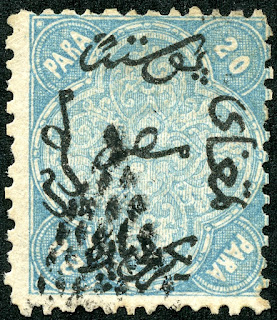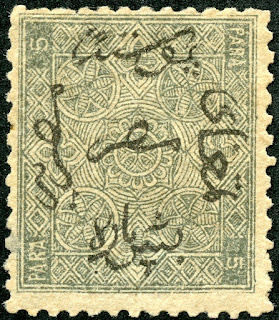Egypt 1866 Scott 3 20pa blue
Surcharged in Black - Turkish Suzerainty
Into the Deep BlueEgypt was part of a Turkish Suzerainty until 1914, when a British protectorate was declared. When Egypt was part of Turkey, a series of governors owed nominal allegiance to the Sultan of Turkey.
Note: The original blog post & BB checklist for Egypt is here. In there I say...
"In reality, since the Suez Canal was built with the French in 1869, the Egyptian government with the Head of State, the Khedive from 1867 to 1914, and the Sultans after 1914, were required to have French and British controllers in the Egyptian cabinet. But finally, an independent Kingdom was established in 1922."
The first stamp issue under the Turkish Suzerainty was a series of seven definitives released January 1, 1866. Let's take a closer look at that first issue.
40 Paras = 1 Piaster
Egypt 1866 Scott 1 5pa greenish gray
Lithographed, Wmk 118
Surcharged in Black - Turkish Suzerainty
All of the stamps are lithographed (save one typographed: the 1pi) by Pellas Brothers of Genoa. They are surcharged in black with the lowest group of characters indicating the value.
Wmk 118 Pyramid and Star
The 1866 issue is on watermarked paper (except 1pi with no watermark) showing a Pyramid and Star (Wmk 118). This is the only issue of Egypt showing this watermark.
Egypt 1866 Scott 2 10pa brown
Surcharged in Black - Turkish Suzerainty
One will note that each denomination has a unique design.
Egypt 1866 Scott 3 20pa blue
Surcharged in Black - Turkish Suzerainty
Stamps are usually perforated 12 1/2, but many other perforations exist (13, 12 1/2 X 13, 12/12 X 15, 13 X 121/2,), which are of higher CV ($60-$550). So it behooves the collector to check perforations. My examples are all 12 1/2.
Egypt 1866 Scott 4 2pi yellow
Surcharged in Black - Turkish Suzerainty
Of interest, the 2pi yellow (above) has been found on cover as a bisected diagonal for a 1pi value. The bisected value was authorized for use between July 16-31 at Alexandria or Cairo. CV (on cover) $3000.
Egypt 1866 Scott 7 1pi rose lilac
Typographed, Unwatermarked
Surcharged in Black - Turkish Suzerainty
The 1pi rose lilac (claret) was issued typographed, and without watermark. The CV for the seven stamp definitive issue ranges from $5+ to $300+.
H.R, Harmer NY 2016 Worldwide Rarities AuctionEgypt (to 1922) Lot 11
1866 registered cover Cairo to Tanta
1866 Scott 4 2pi yellow & Scott 7 1pi rose lilac
This is a reminder that classic era stamps often have much more value if left on cover. The 2 pi yellow and 1pi rose lilac are CV ~$60 off cover. Here, on cover: $5000!
Out of the Blue
Most of us are familiar with the "Sphinx and Pyramid" Egypt designs from 1867-1906. But, I'll bet few of us would recognize the 1866 stamps as being Egyptian!
Note: Cover illustration from internet is from an H.R. Harmer auction, and is shown here for educational reasons.
Comments appreciated!








No comments:
Post a Comment